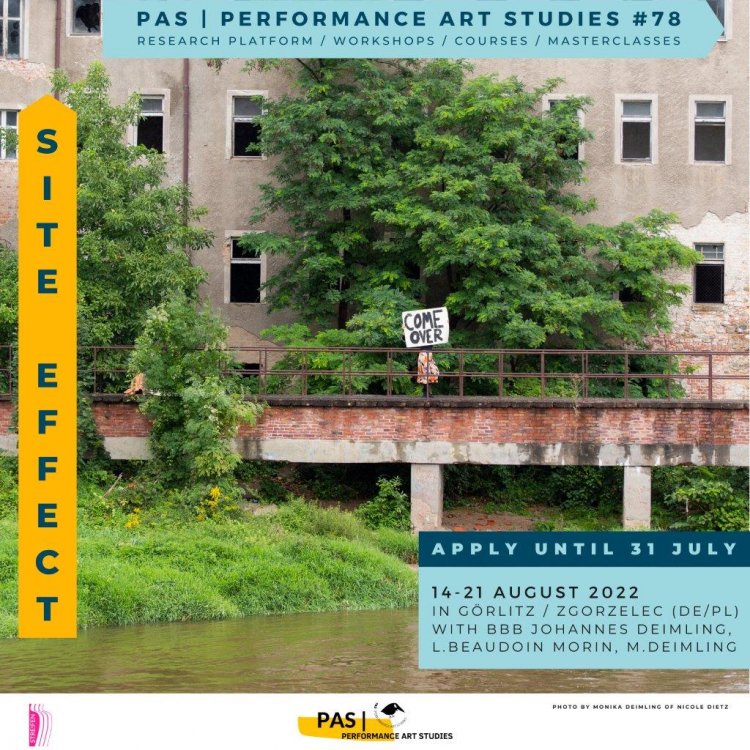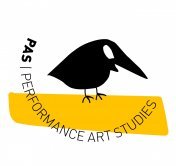- Jobs
- Open Calls
- Events
- Learning
- More
- SUBMIT
Performance Art Workshop: SITE EFFECT - PAS #78
Submitted by PAS Performance Art Studies on Sun, 05/08/2022 - 12:12
Type:
Category:
Country:

Description:
SITE EFFECT
An 8-day learning program on site-specific and time-specific Performance Art practice in collaboration with STRE!FEN Performance Art Festival in Görlitz (Germany) and Zgorzelec (Poland). Led by the PAS | Team: BBB Johannes Deimling, Laurence Beaudoin Morin and Monika Deimling.
For the third time PAS is collaborating with the STRE!FEN Performance Art Festival in Görlitz and Zgorzelec. After two successful PAS studies in 2020 and 2021 we continue the bonds and exchange that we have established to deepen site-specific performance art research.
Click here to see the process publication of PAS #74 | “SITE SEEING” in 2021
Click here to see the festival catalog of STRE!FEN 2021
The main topic of the collaboration between PAS | Performance Art Studies and STRE!FEN is the site-specific approach to performance art practice, theory and philosophy. Since the start of this collaboration each PAS | Study is researching urban spaces on both sides of the German-Polish border urban spaces that would create a resonance through performance art.
With “SITE-EFFECT” we want to examine the possibilities of urban sites and spaces through performance that would influence the surrounding of a chosen site. The aim is to extend the impact of an action in urban spaces that can be understood as a trigger to provoke artistic side effects.
The city is the ‘classroom’
The focus of PAS #78 | “SITE EFFECT” is the site-specific and time-specific approach of performance art practice, theory and philosophy. The border cities Görlitz (Germany) and Zgorzelec (Poland) will be our classroom and the center of attention for the site-specific artistic research which will lead to public performances at different spots in the cities – on both sides of the border. We will explore and discover the border cities by bike and by foot and research its historic, political, architectural and social potential for performance art purpose.
Site-specific performance art
“If you work site-specific, you need to be very specific with the site” (BBB Johannes Deimling)
The term site-specific describes artistic production in close relation with a physical site. Since its appearance in performance art the term “site-specific performance” has influenced and inspired performance art practice and theory until today.
One could state that each performance work is site-specific since it is always happening in a spatial context and corresponding in one way or the other with the surrounding in which it appears. This thought is supported by the fact that our human body is not able to leave space since it surrounds us the moment we start growing in the uterus.
But the term “site-specific” describes not only a form or state of being but more a working method, a research practice which resonates in so many fields alongside the arts: ecology, humanity, history, politics, time, etc. The spatial context, the site-specific aspect of artistic production, presentation and perception is a reservoir of diverse and – it seems – endless artistic potential to create site related artworks.
The site-specific research is strongly connected to time. A performance will look different in a context of time that goes as far as the site-specific research. It is not only the context to the current situation, but also very profound aspects like day and night or summer and winter or any other connection that time can build in cooperation with a space. The dialogue between site and time will generate vivid artistic research that will create strong and responding performance art works.
STRE!FEN
The German word “Streifen” means stripe, but also to touch, to graze, to roam, to swipe and combines a lot of other sensual meanings. STRE!FEN stands in its meanings firstly for the abstract form, which can be space, border and connection at the same time, secondly for the light, gentle touch and thirdly for the unintentional but exploratory movement. A special space. A special contact. A special movement.
The various meanings of the word “Streifen/streifen” will be the method of our artistic research. Görlitz and Zgorzelec are used as an art space, we work in the social, cultural and political context of the city, we deal with local conditions and structures, architecture, history and above all – with the people.
The border between Görlitz and Zgorzelec is marked by a river (Neiße) a moving stripe which is a contact point, gentle and careful, sometimes unintentional, a sensing, exploring and a first perception of another existence. How do we meet each other? How do we go on? Are we curious about each other?
Schedule:
14 August 2022: official start 10:00, place to be announced
14 – 20 August 2022: practical studies and research in both border cities
20 August 2022: final presentation (throughout the whole day at different locations in the cities)
21 August 2022: reflection, brunch and closing day, departure (15:00)
Level:
Duration:
14. – 21. August 2022
Date:
Monday, August 1, 2022
Price:
Regular fee: € 310 (Price does NOT include travel and accommodation costs) Early bird price: € 250 for registrations until 1. July 2022.
Qualification:
Certificate and the medal of performance
Host & Provider:
Provider's Link:






